The Pedestrian Access Control System Market is estimated to be valued at USD 3.2 billion in 2025 and is projected to reach USD 5.6 billion by 2035, registering a compound annual growth rate (CAGR) of 5.8% over the forecast period.
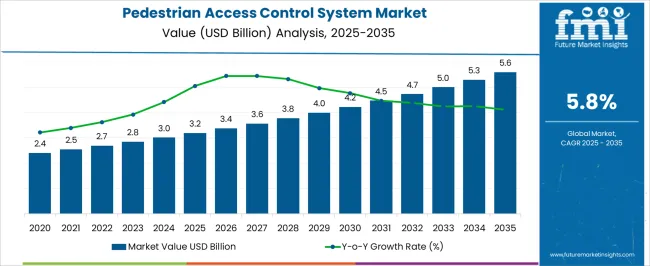
| Metric | Value |
|---|---|
| Pedestrian Access Control System Market Estimated Value in (2025 E) | USD 3.2 billion |
| Pedestrian Access Control System Market Forecast Value in (2035 F) | USD 5.6 billion |
| Forecast CAGR (2025 to 2035) | 5.8% |
The pedestrian access control system market is experiencing strong growth, driven by the rising need for secure and efficient management of people flow across commercial, financial, government, and transportation sectors. Increasing safety concerns, regulatory requirements for access monitoring, and the adoption of smart building technologies are contributing to market expansion. Integration of biometric authentication, IoT-enabled devices, and real-time monitoring software is enhancing system capabilities, enabling enterprises to improve security, reduce unauthorized access, and optimize operational efficiency.
Growing investments in digital infrastructure and security upgrades in banking, corporate, and public institutions are driving adoption of advanced access control solutions. The shift toward automated and software-managed systems is also influencing the market, as traditional security mechanisms are being replaced with scalable, easy-to-manage platforms.
With increasing emphasis on security, regulatory compliance, and efficiency, the pedestrian access control system market is poised for sustained growth Technological innovations and the rising deployment of smart building solutions are expected to create long-term opportunities for market players across multiple end-use industries globally.
The pedestrian access control system market is segmented by type, end uses, and geographic regions. By type, pedestrian access control system market is divided into Turnstiles and Gates. In terms of end uses, pedestrian access control system market is classified into Banking/Financial Services, IT Services, Hospitality, Retail, and Others. Regionally, the pedestrian access control system industry is classified into North America, Latin America, Western Europe, Eastern Europe, Balkan & Baltic Countries, Russia & Belarus, Central Asia, East Asia, South Asia & Pacific, and the Middle East & Africa.
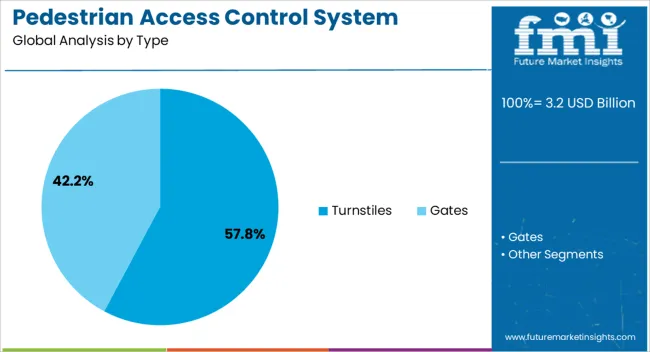
The turnstiles type segment is projected to hold 57.8% of the pedestrian access control system market revenue share in 2025, making it the leading product type. This dominance is being driven by the reliability and efficiency of turnstiles in controlling entry and exit points while maintaining smooth pedestrian flow in high-traffic areas. Turnstiles enable automated monitoring and integration with smart security systems, reducing the need for manual supervision and minimizing human error.
The segment benefits from the growing adoption of advanced features such as biometric scanners, RFID access cards, and cloud-based management software, which enhance security and operational efficiency. Its deployment is highly favored in commercial buildings, transport hubs, and high-security facilities due to its ability to provide consistent and robust access control while accommodating large volumes of people.
The segment’s scalability, adaptability, and proven effectiveness in reducing unauthorized access have reinforced its position as the preferred choice in the market Continuous innovation in design and integration is expected to sustain the leadership of turnstiles within this sector.
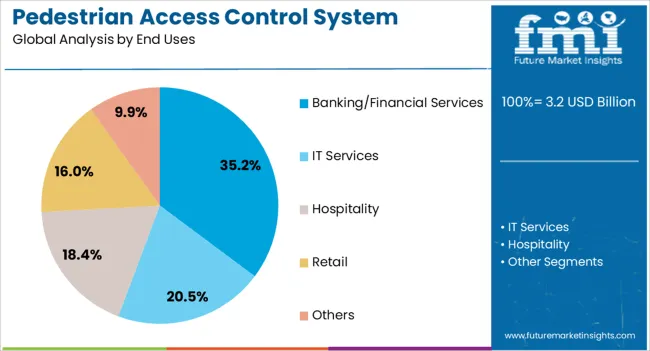
The banking and financial services end-use segment is expected to account for 35.2% of the pedestrian access control system market revenue share in 2025, establishing it as the leading end-use industry. This leadership is being driven by stringent regulatory requirements, the need to protect sensitive financial information, and the high-value nature of assets stored within financial institutions.
Banks and financial service providers are increasingly investing in advanced access control systems to prevent unauthorized entry, safeguard staff and customers, and improve operational efficiency. The integration of turnstiles with biometric authentication, smart card readers, and surveillance systems allows for seamless management of employee and visitor access.
Additionally, these solutions provide real-time monitoring and auditing capabilities, ensuring compliance with security and regulatory standards The growing focus on digital transformation and smart branch initiatives is further accelerating adoption within this segment, positioning banking and financial services as the primary driver of revenue growth in the pedestrian access control system market.
Security concerns require an immediate response these days, whether in the residential, commercial, industrial, defence, or government sectors. Global risks from anti-social elements must be handled in a more intelligent and strong manner hence, it is considered to be the most practical solution. Pedestrian access control systems are designed to identify and grant quick access to people who have the proper credentials. These devices are primarily used to control the flow of people at popular tourist destinations.
Various organisations and companies have begun to use and install pedestrian access control systems to assure security (especially entrance gates, speed gates, full-height turnstiles, tripod turnstiles, and others). Thus, due to these benefits, the demand for pedestrian access control systems is increasing from several end users.
The market analysis for Pedestrian Access Control Systems from 2025 to 2025 exhibited a historical growth rate of 2.3% CAGR, with growing security concerns and ensuring public safety being the primary factors driving the market expansion from 2025 to 2025.
However, according to the most recent FMI analysis, the Pedestrian Access Control System is expected to grow at a rate of 5.8% between 2025 and 2035. Due to rising security concerns around the world, pedestrian access control systems have now become essential. Large organisations are increasingly interested in automatic pedestrian access control systems. With the increasing requirement to secure data and manage pedestrian traffic, these access control systems are expected to be a major target market in the near future.
Multi-factor authentication is a security system that needs more than one authentication step from a separate class of credentials to verify the identity of users before they can enter, access, or log into a pedestrian access control system. This new security trend involves two or more steps of authentication. These steps include scanning fingerprints, swiping cards, and finally answering security questions for access.
With the increasing frequency of security breaches in current single-factor authentication pedestrian access control systems, organisations have begun to focus on developing highly secure multi-factor authentication methods. To provide improved security, the new technology requires an individual to submit more than one password while logging in. The pedestrian access control systems market is expected to expand rapidly during the forecast period.
The switch from keys to keyless has reduced the stress associated with problems related to keys, such as their misplacement. It has also improved end users' experiences because pedestrian access control systems are faster in processing, more efficient, and provide more alternatives for unlocking doors and remote accessibility.
High implementation costs, a lack of a reliable communication and information processing system, and security-related disputes are major obstacles in the pedestrian access control system market.
In developing countries, due to the lack of technologies, there is a dearth of infrastructural developments, which leads to little penetration of numerous pedestrian access control systems, such as entrance gates, speed gates, full-height turnstiles, optical turnstiles, and tripod turnstiles. This acts as a key restraint for the pedestrian access control system market. Lack of awareness and knowledge related to technological innovation among customers can lead to complexity and also hinder the growth of the market.
In terms of revenue share, the North America region led the global market in 2025. Because of the existence of a high number of USA-based users and prominent market competitors, North America is seeing greater adoption of pedestrian access control systems. Furthermore, the government in this region is substantially investing in the research and development of pedestrian entrance control systems, which is expected to drive market growth. In Europe, the government sector is witnessing the increasing adoption of pedestrian access control systems that provide seamless access to authorised persons, support border management, and help manage the workforce effectively.
South Asia and the Pacific are expected to be the fastest-expanding markets for pedestrian access control systems due to technological advancements, greater investment in the residential and commercial sectors, and general economic expansion. Additionally, Latin America and the Middle East and Africa region are expected to see favourable growth in the forecast period.
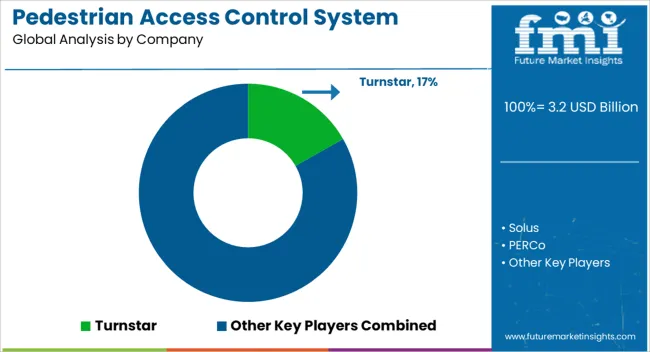
Key players operating in the Pedestrian Access Control System market include Magnetic Autocontrol Pvt. Ltd., Turnstar, Solus, Magnet Security & Automation System Solution, PERCo and FAAC Group.
Key players' strategies for increasing sales include regional development and agreements with other pedestrian entrance control system suppliers. The pedestrian entrance control systems market will gain momentum as a result of new product developments and key market players' strong financial positions.
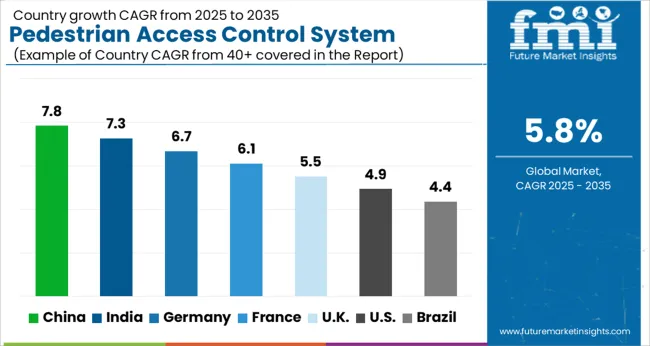
| Country | CAGR |
|---|---|
| China | 7.8% |
| India | 7.3% |
| Germany | 6.7% |
| France | 6.1% |
| UK | 5.5% |
| USA | 4.9% |
| Brazil | 4.4% |
The Pedestrian Access Control System Market is expected to register a CAGR of 5.8% during the forecast period, exhibiting varied country level momentum. China leads with the highest CAGR of 7.8%, followed by India at 7.3%. Developed markets such as Germany, France, and the UK continue to expand steadily, while the USA is likely to grow at consistent rates. Brazil posts the lowest CAGR at 4.4%, yet still underscores a broadly positive trajectory for the global Pedestrian Access Control System Market. In 2024, Germany held a dominant revenue in the Western Europe market and is expected to grow with a CAGR of 6.7%. The USA Pedestrian Access Control System Market is estimated to be valued at USD 1.2 billion in 2025 and is anticipated to reach a valuation of USD 1.9 billion by 2035. Sales are projected to rise at a CAGR of 4.9% over the forecast period between 2025 and 2035. While Japan and South Korea markets are estimated to be valued at USD 158.1 million and USD 108.1 million respectively in 2025.
| Item | Value |
|---|---|
| Quantitative Units | USD 3.2 Billion |
| Type | Turnstiles and Gates |
| End Uses | Banking/Financial Services, IT Services, Hospitality, Retail, and Others |
| Regions Covered | North America, Europe, Asia-Pacific, Latin America, Middle East & Africa |
| Country Covered | United States, Canada, Germany, France, United Kingdom, China, Japan, India, Brazil, South Africa |
| Key Companies Profiled | Turnstar, Solus, PERCo, Magnetic Auto control Pvt. Ltd., Magnet Security & Automation System Solution, FAAC Group, Nortek Control, KABA Group, and Bosch Sicherheits system GmbH |
The global pedestrian access control system market is estimated to be valued at USD 3.2 billion in 2025.
The market size for the pedestrian access control system market is projected to reach USD 5.6 billion by 2035.
The pedestrian access control system market is expected to grow at a 5.8% CAGR between 2025 and 2035.
The key product types in pedestrian access control system market are turnstiles and gates.
In terms of end uses, banking/financial services segment to command 35.2% share in the pedestrian access control system market in 2025.






Our Research Products

The "Full Research Suite" delivers actionable market intel, deep dives on markets or technologies, so clients act faster, cut risk, and unlock growth.

The Leaderboard benchmarks and ranks top vendors, classifying them as Established Leaders, Leading Challengers, or Disruptors & Challengers.

Locates where complements amplify value and substitutes erode it, forecasting net impact by horizon

We deliver granular, decision-grade intel: market sizing, 5-year forecasts, pricing, adoption, usage, revenue, and operational KPIs—plus competitor tracking, regulation, and value chains—across 60 countries broadly.

Spot the shifts before they hit your P&L. We track inflection points, adoption curves, pricing moves, and ecosystem plays to show where demand is heading, why it is changing, and what to do next across high-growth markets and disruptive tech

Real-time reads of user behavior. We track shifting priorities, perceptions of today’s and next-gen services, and provider experience, then pace how fast tech moves from trial to adoption, blending buyer, consumer, and channel inputs with social signals (#WhySwitch, #UX).

Partner with our analyst team to build a custom report designed around your business priorities. From analysing market trends to assessing competitors or crafting bespoke datasets, we tailor insights to your needs.
Supplier Intelligence
Discovery & Profiling
Capacity & Footprint
Performance & Risk
Compliance & Governance
Commercial Readiness
Who Supplies Whom
Scorecards & Shortlists
Playbooks & Docs
Category Intelligence
Definition & Scope
Demand & Use Cases
Cost Drivers
Market Structure
Supply Chain Map
Trade & Policy
Operating Norms
Deliverables
Buyer Intelligence
Account Basics
Spend & Scope
Procurement Model
Vendor Requirements
Terms & Policies
Entry Strategy
Pain Points & Triggers
Outputs
Pricing Analysis
Benchmarks
Trends
Should-Cost
Indexation
Landed Cost
Commercial Terms
Deliverables
Brand Analysis
Positioning & Value Prop
Share & Presence
Customer Evidence
Go-to-Market
Digital & Reputation
Compliance & Trust
KPIs & Gaps
Outputs
Full Research Suite comprises of:
Market outlook & trends analysis
Interviews & case studies
Strategic recommendations
Vendor profiles & capabilities analysis
5-year forecasts
8 regions and 60+ country-level data splits
Market segment data splits
12 months of continuous data updates
DELIVERED AS:
PDF EXCEL ONLINE
Card-Based Electronic Access Control Systems Market Growth - Forecast 2025 to 2035
North America Keyless Vehicle Access Control Market - Growth & Forecast through 2035
Access Control as a Service Market Size and Share Forecast Outlook 2025 to 2035
Access Control Market Analysis - Size, Share, and Forecast 2025 to 2035
Access Control and Authentication Market Analysis & Forecast by Technology, Component, Application and Region through 2035
Access Control Readers Market
HVAC Control System Market Size and Share Forecast Outlook 2025 to 2035
Dust Control System Market Size and Share Forecast Outlook 2025 to 2035
Noise Control System Market Analysis - Size, Share, and Demand Forecast Outlook 2025 to 2035
Odour Control System Market Growth - Trends & Forecast 2025 to 2035
Spinal Access Systems Market Size and Share Forecast Outlook 2025 to 2035
Door Controller Systems Market
Pedestrian Protection System Market Size and Share Forecast Outlook 2025 to 2035
Network Access Control (NAC) Market Size and Share Forecast Outlook 2025 to 2035
Version Control Systems Market Size and Share Forecast Outlook 2025 to 2035
Machine Control System Market Growth – Trends & Forecast 2025 to 2035
Vascular Access System Market Size and Share Forecast Outlook 2025 to 2035
Building Access Control Security Market Size and Share Forecast Outlook 2025 to 2035
Charge Controller System Market Analysis - Size, Share, and Forecast Outlook 2025 to 2035
Adaptive Access Control Market Growth – Trends & Forecast through 2034

Thank you!
You will receive an email from our Business Development Manager. Please be sure to check your SPAM/JUNK folder too.
Chat With
MaRIA